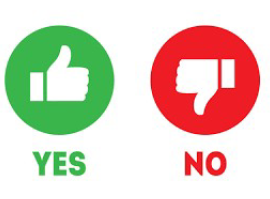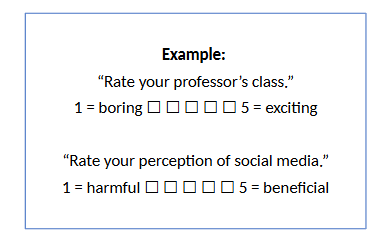Research Methods Exam 3
1/26
There's no tags or description
Looks like no tags are added yet.
Name | Mastery | Learn | Test | Matching | Spaced |
|---|
No study sessions yet.
27 Terms
Surveys & Polls
—Method of asking ppl to self-report their attitudes, behaviors, or opinions
—Conducted face-to-face, otp, written questionnaires, or online
—Diff ways of asking these questions
—Must ensure we’re collecting accurate data
Ensuring Construct Validity of Surveys/Polls
Choosing types of questions
Writing well-worded questions
Encouraging Accurate Responses
Types of Survey Questions
Open-Ended
Forced-Choice
Likert Scale
Semantic Differential
Open-Ended Questions
Respondents can answer freely
Example of Open-Ended Question
“Comment on your experience as a student at SUNY New Paltz”
Pro and Con of Open-Ended Questions
Pro: Provides rich, detailed information
Con: Coding and categorizing responses is time-consuming

Forced-Choice Questions
Participants choose the best option from two or more choices, commonly used in political polls
Examples for Forced-Choice Questions
“For which candidate will you vote: A or B?”
“What describes you best?”
I like being the center of attention
It makes me uncomfortable to be the center of attention
Pros and Cons of Forced-Choice Questions
Pros: Quick to analyze; clear, comparable responses
Cons: Limited insight; may not reflect true views

Likert Scale Questions
Respondents rate their level or intensity of attitude, opinion, or experience on a scale. Measures how respondents think.
Example of Likert Scale Questions
Scales typically range from one extreme to another, Common anchors:
Strongly disagree—> Strongly agree
Never—→ Always
Pros and Cons of Likert Scale Questions
Pros: Easy to interpret; captures degree of opinion
Cons: Can lead to neutral or patterned responses

Semantic Differential Format Questions
Respondents rate a target (concept, object, or person) using bipolar adjective pairs as endpoints. Measures how respondents feel.
Examples of Semantic Differential Format Questions
boring——>exciting
unpleasant—→pleasant
disorganized—→organized
Pros and Cons of Semantic Differential Format Questions
Pros: Captures attitudes, flexible, quick, easy to compare
Cons: Interpretation varies, midpoints ambiguous
Likert vs. Semantic Differentials
Both are rating scales used to measure attitudes
Likert: focuses on agreement with statements (cognitive, belief-based), often used in psychology and social research for clear opinions
Semantic Differential: focuses on emotional tone or perception (feeling-based), common in marketing or perception studies for emotional meaning
The choice depends on what kind of info you want:
Use Likert for what people think
Use Semantic Differential for how people feel
Writing Effective Questions
Clear wording helps both researchers and participants understand questions accurately
Common Pitfalls to Avoid:
Leading Questions
Double-Barreled Questions
Negative Wording
Also consider: Question Order
Leading Questions
The goal of a survey is to capture respondents’ true opinions. Questions that suggest certain answers can bias responses. Sometimes two questions seem to be asking the same thing, but they yield very different responses based on the wording.
Example of Leading Questions
V1) How fast do you think the driver was going when he hit the other car?
V2) How fast do you think the driver was going when he smashed into the other car?
Solution to Leading Questions
Use Neutral Wording
Double-Barreled Questions
Asking two things at once in the same question; Causes confusion for the respondent and researcher
Examples of Double-Barreled Questions
Do you agree with the new tax bill and immigration policies of this administration?
Do you enjoy swimming and wearing sunscreen?
Solution to Double-Barreled Questions
Split into separate questions:
“Do you agree with the new tax bill?”
“Do you agree with the immigration policies?”
Keep each question focused:
“Do you enjoy swimming?”
“Do you enjoy wearing sunscreen?”
Negative Wording
Questions that use negatives; Can cause confusion for respondents
Example of Negative Wording
“Do you not support the new policy?”
Solution to Negative Wording
Avoid double negatives and using positive/neutral wording is easier to understand